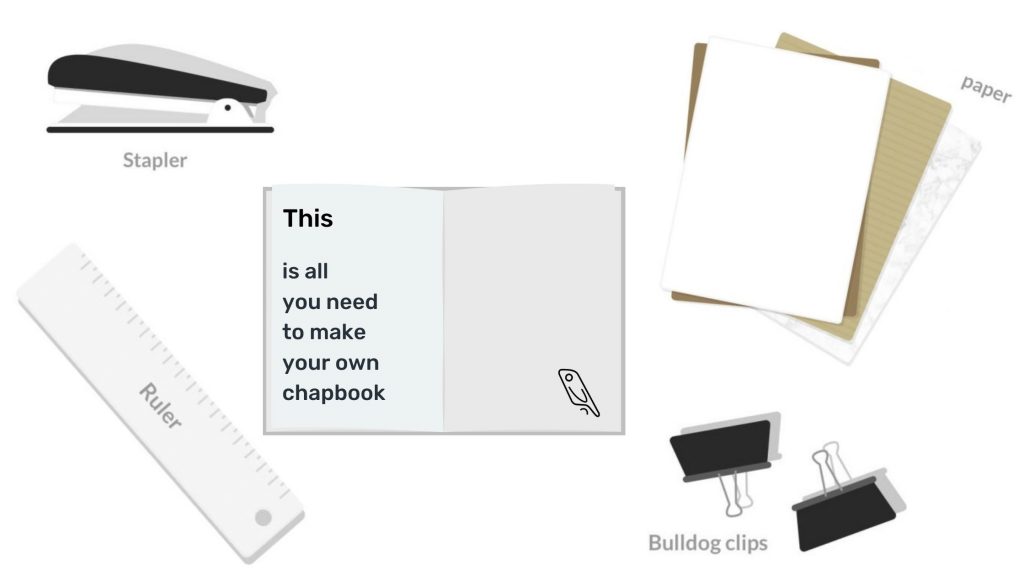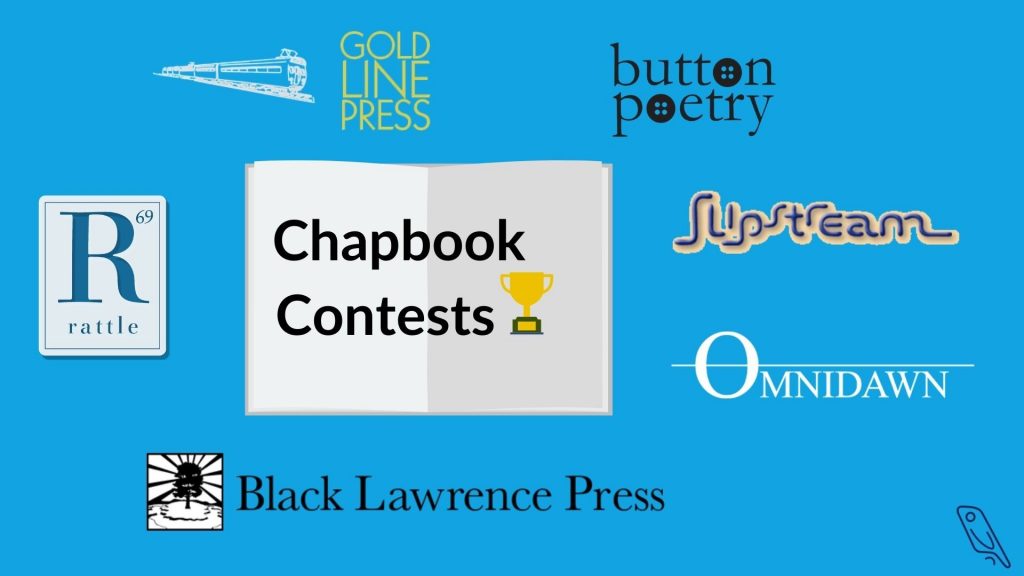Last updated on Oct 15, 2025
How to Make a Chapbook in 4 No-Nonsense Steps
Savannah Cordova
Savannah is a senior editor with Reedsy and a published writer whose work has appeared on Slate, Kirkus, and BookTrib. Her short fiction has appeared in the Owl Canyon Press anthology, "No Bars and a Dead Battery".
View profile →If you're currently in the process of growing your readership as a poet, you're going to need to know how to make a chapbook. These short books can help kickstart your literary reputation, and may well increase your chances of getting signed for your debut poetry collection. Sounds good?
From polishing your verse to hand-making a DIY chapbook and getting your words out into the world, here is our 4-step guide to making a chapbook:
1. Ruthlessly edit your poems
We assume you already know how to write a poem (but if you want to brush up on your skills, you can read this blog post), so it’s now a case of editing your work. Published works live forever, so make sure you’re completely happy with the quality of your writing before committing it to print! Read your poems aloud, share them with writer friends or a critique circle to get feedback, or, even better, get the help of a professional poetry editor.
Poetry, as a form, is about distillation. It’s your job to question every single word, and trim off excess language to sharpen and crystallize your thoughts. Finally, proofread your poems carefully to rid it of typos and errors.

Give your chapbook the help it deserves
The best poetry editors are on Reedsy. Sign up for free and meet them.
Learn how Reedsy can help you craft a beautiful book.
2. Assemble your poems into a cohesive whole
Your next step is to assemble your best work. You have to curate these in an order that makes sense to you, the poet. There’s really no right or wrong way to go about this — you can arrange them in order of the date they were written (e.g. if the book charts a period in time), by theme, subject matter, or simply by mood.
There’s no guarantee your reader will read through the whole thing from start to finish, but you have to work under the assumption that they will in order to shape your chapbook. (Reading a bunch of poetry books should help you understand how other poets go about doing this!)

3. Format your poems (no need to be fancy)
When you're learning how to make a chapbook, formatting and designing the interior layout can sound like daunting fields to venture into. But they don't have to be. Inevitably, less is more. Stick to a simple serif font like Bembo, Garamond or Minion (more on book fonts in our typography post here), a standard font size like 12pt, and only feature one poem per page, even if they’re short.
Remember to include:
- An interior title page;
- A table of contents;
- An acknowledgements page;
- Your author bio (learn how to write one here);
- Any information related to copyright, e.g. where certain poems were first published.
If any of the above is unclear, head to our breakdown of all the parts of a book to demystify each part or this guide on book formatting — though bear in mind not all of these will apply to chapbooks! Finally, you can use Reedsy Studio to typeset your chapbook to a professional standard for free. (We'll even generate a super serious-looking copyright page© for you.)
We understand that chapbooks don't traditionally get made with a huge production budget, but if you've got the funds, we always advise that you work with a professional book interior designer to prepare your chapbook. Head over to our post on poetry book layout to see how pros can really help your poems seize their readers' hearts.
4. Choose one of four publishing paths
When it comes to choosing how to publish your chapbook, it's a classic self vs. traditional publishing dilemma. Great writers inevitably fall through the cracks of traditional publishing, simply because independent publishers who are unaffiliated to the big 5 don’t have the budget to champion as many poets as they’d like to. For that reason, some poets learn how to make a chapbook and publish it themselves. You definitely stand a better chance of actually making profit from your chapbook if you self-publish it, but that means going without the helpful exposure and publicity a publisher can offer and coming up with a strategy on your own.
Self-publishing:
- The old-school DIY way
- The 21st century way: Print-on-Demand
Traditional publishing:
- Chapbook contests
- Securing a book deal
Let's take a look at your options to help you decide.
Old-school self-publishing: How to make a chapbook by hand

Chapbooks have a long history of self-publishing, so you could embrace that old-school punk spirit and make your chapbook at home. Obviously, this means a very limited edition run, but embracing obscurity is again in line with the punk spirit. Punk isn't mainstream!🤟 That doesn't mean noone will read your work. It just means you won't be selling your book on Amazon or in large brick-and-mortar bookstores (you can definitely try local, independent bookstores). You can still sell handmade copies at local markets or on digital platforms like Etsy, or promote them via an Instagram page. It's simply a matter of reaching a different crowd.
Pro tip: If you have a small following and want to grow it, a self-published chapbook could be perfect for you. However, if you're new to the poetry scene, consider waiting until you’ve published poetry in literary magazines, so your chapbook can attract more attention.
More about how to publish poetry here and a list of literary magazines to submit to here.
If you're up for the DIY challenge, follow the following steps. It's super easy!

1. First, you have to figure out which pages correspond to each sheet of paper.
In the printing world, this is called creating a "signature". Here's an example of where you'd need to print each page to create a 16-page chapbook.

Is this making your brain melt? Yeah, same here. To figure out exactly where each page needs to be before you go to print, fold pieces of scrap paper together into a mock-chapbook, and label each page with its number. Then, when you pull the pages apart, each sheet's numbers will guide the placement of pages in your manuscript. 🧠
Pro tip: If you're still having trouble with this, head to your local copy shop to print a sample copy. If you explain that you want to bind a chapbook, they'll know exactly where to place each page, and they'll staple them together, too.
2. Once all of your pages are printed, it's time to fold them.
This can get boring quick, so feel free to pop on a nice audiobook or writing podcast while you're at it. Use your ruler to make sure you fold each sheet in its exact middle. You can also fold the paper along the edge of your ruler to speed up the process! 🎧
3. Now that all of your pages have a middle crease, gather every sheet you need for each copy and unfold it.
Carefully place all the sheets comprising one chapbook in a neat pile on your work surface. Make sure that the cover exterior is the sheet facing upward, and the sheet facing the work surface is the middle of the chapbook. 📄
4. Double check that the pages are in the right order, then secure their ends with bulldog clips to ensure that they stay in place.
You don't want to have to tear staples out because the paper wasn't aligned 15 chapbooks in, so be thorough. 🚨
Hire an expert poetry editor
Kristin G.
Available to hire
I'm a published poet who wants to make your writing sing. I specialize in copy editing and proofreading fiction and poetry.
Angela Yuriko S.
Available to hire
Publishing coach, multi Bram Stoker Awards® Winner+, publisher of Space and Time and Authortunities, a calendar of author opportunities.
Aaron L.
Available to hire
Editor in Chief of an art & lit website and English educator who loves all forms of creative writing—both poetry and prose.
5. Using your ruler, make a very small pencil mark one-third and two-thirds into the central sheet's middle crease.
Staple the paper together at those two points using your staple. That's one chapbook done!✨

6. Repeat as needed. 🔁
Easy, right? If you loved the DIY aspect of chapbook-making, check out our post on how to make a book (as in, a proper, hardback book) yourself.
21st-century self-publishing: Print-on-demand
Not to kill the punk spirit, but we actually recommend going the print-on-demand way if you choose to self-publish. As the name suggests, is a printing service where, rather than print a large batch of books in advance, you print one copy of your book every time someone orders it. Other services are likely to be much less cost-efficient.
In comparison to offset printing, print-on-demand is more cost-effective for smaller print runs, it's faster, and also means you won't need to store cardboard boxes full of books in your living room or basement. Instead, the printer sends books directly to customers!
Compared to DIY chapbooks, print-on-demand ones are much sleeker and professionally finished, which inevitably lends your book a more serious look (not saying it should, but it does). Finally, its most obvious advantage over making your chapbooks at home is the simple truth that you also save tons of time you'd otherwise spend fiddling with a stapler and ruler.
Traditional publishing: Chapbook contests

Chapbook contests, with their handy cash prizes and promises of publication and prestige, are a dreamy scenario for the lucky and talented poets who win them. That said, there are two things to be wary of:
❗ As with all writing contests, always read the fine print before submitting your poetry. Some contests will offer cash as a prize, while others consider it an advance for the publication of your chapbook. Make sure you’re clear about what the prize is exactly before you send your work out into the world.
❗ Most contests do charge an entry or ‘reading’ fee, so it’s up to you to verify that each is reputable, legitimate and not a scam contest. You also need to decide which contests’ prizes are worth the entry fees; this is a matter of a simple cost-benefit analysis.
Note: Usually, chapbook contests aim to discover new voices and share them with the public. However, a minority of contests, like the Candlestick Press one, set a theme and publish the selected poems in a single, anthology-style chapbook featuring several poets.
Here’s a few reputable chapbook contests to start you off (note that some of these accept prose, too):
- Rattle chapbook contest, prize of $5,000 and publication
- The International Book & Pamphlet competition, prize of a share (equal among winners) of £2,000 and publication
- Slipstream Press chapbook contest, prize of $1,000 and publication
- Omnidawn poetry chapbook contest, prize of $1,000 and publication
- The New Michigan Press / DIAGRAM chapbook contest, prize of $1,000 and publication
- Button Poetry chapbook contest, prize of $500 and publication
- The Black River chapbook competition, prize of $500 and publication
- Gold Line Press chapbook contest, prize of $500 and publication
- The Adrift chapbook contest, prize of $300 and publication
Traditional publishing: submitting directly to publishers

Large publishing houses don’t really print chapbooks — their focus is on longer poetic collections. So if you’re hoping to place your chapbook with a publisher, you’ll need to find smaller presses specializing in poetry. Several accept direct submissions, so you need to use Google to your advantage to find the best options for you. A few examples include Big Game Press, Noemi Press, Dancing Girl Press and Letter Machine Editions (not open to submissions at the time of writing) in the US, and Maytree Press in the UK.
Whether you follow the traditional or self-publishing route, we wish you a great success with your chapbook!


